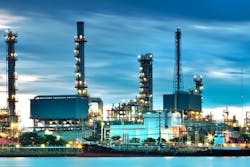The chemicals industry is demanding improved internal efforts and safeguards from chemical sector companies to reduce operational risk and safety concerns. Central to the modern world’s economy, the chemicals industry converts raw materials into more than 70,000 different products and employs upward of 1.2 million people in the European Union. The chemical industry in the U.S. employs approximately 810,000. The nature of working with hazardous materials under significant pressure and heat, can mean workers are often exposed to danger. How can chemical sector companies ensure they are fulfilling duty of care by protecting the welfare of their employees?
Companies are responsible for the health and safety of their employees and any customers or suppliers visiting their premises. Delivering effective risk management is not easy in the chemicals industry. However, the penalties for failure – its impact on people, environment, reputation and revenues – are extreme. If key risks are not appreciated and then ensured, or otherwise mitigated, a chemicals company could face a spectrum of negative consequences. Though many companies are taking responsible steps to eradicate possible dangers, reducing risk must be at the center of all new projects going forward. New technology and an increased awareness of safety is set to be the driving force behind operational reform.
Safety above all
On June 1, 1974, 28 people were killed and 36 injured in an explosion at a chemical plant in Flixborough North Lincolnshire, England. Of the 72 personnel on site, only eight people walked away unscathed. Fires continued on-site for more than 10 days and almost 2,000 properties were damaged.
There are many potential causes of such an accident, including the sudden release of gas under pressure or the introduction of an ignition source into an explosive or flammable environment.
However, technology can now help the chemical industry to more effectively sense, measure and monitor gas flow, providing the accurate information necessary to make more effective decisions.
The chemical industry relies on combining raw materials, often under pressure and at heat, to create usable products. This is a dangerous environment if not carefully monitored and measured. With the accurate measurement of fluids and gases, particularly under pressure, a flowmeter can be an essential element to safely creating chemical solutions.
The Flixborough disaster involved – and may have been caused by – hasty installation of bypass pipework. It was found that mechanical engineering issues were overlooked by chemical engineers. The inquiry into the disaster identified “lessons to be learned,” which it presented under various headings: “General observation” (relating to cultural issues underlying the disaster), and “specific lessons” (directly relevant to the disaster, but of general applicability).
Flixborough led to widespread public outcry over process plant safety. Together with the passing of the Health and Safety at Work Act in the same year it led to a more systematic approach to process safety in U.K. process industries and to explicit U.K. government regulation of plant processing or storing large inventories of hazardous materials.
Tragically, Flixborough is not a unique disaster. In 1971 the Thiokol – Woodbine explosion in the country of Georgia killed 29 and injured 50 when an ignition chemical caused a fire to spread through the site. Five years later in Seveso, Italy, a small chemical manufacturing plant of ICMESA released dioxins into the air that killed more than 70,000 animals from surrounding farms. The disaster led to the Seveso Directive, which was issued by the European Community and imposed much stronger industrial regulations.
Connecting technology and separating risk
The U.S. Chemical Safety Board (USCS) has completed investigations into scores of accidents – including a number of chemical plant explosions – and suggested that the use of smarter technology will help plants avoid similar events in the future.
Cloud technology and the availability of internet connectivity now enables remote asset management. Cloud infrastructure is able to support the constant monitoring and storage of data on remote servers anywhere in the world in real time via the Internet of Things (IoT). Monitoring equipment installed on local assets transmits information to software that is stored on central servers, rather than physically on-site. If an asset is malfunctioning – or is about to do so – chemicals companies will be alerted. When this real-time data is fed into software such as a continuous emission monitoring system (CEMS), organizations can then collect, record and report data remotely.
With internet connectivity available almost anywhere, businesses can access the CEMS data feeds of remote assets from multiple sites around the world. It is not necessary to store and run the software on a machine on-site, which removes the need for on-site staff. Additionally, the data is stored securely on multiple remote servers with backup and is not dependent on the health and reliability of an on-site machine.
If companies do not currently have technology to fully automate an installation, starting to collect relevant information now will enable more sophisticated decision-making for the future.
The remote measurement and testing of assets can almost eliminate human risk. With continuous measurement, operators can discover leaks through a process called mass balancing. By accounting for material entering and leaving pipes, mass flows can be identified, which might have been unknown or previously difficult to measure. For example, operators can use mass balancing to identify faulty valves within their pipe systems that may be causing dangerous leaks. Remote action can be taken to update software, shut down failing or faulty systems, and if there is a danger of explosion, alert on-site personnel immediately.
By implementing connected technologies, the chemicals industry is mitigating risk and reducing the threat of a large-scale disaster. Through cloud technology, chemicals companies can remotely manage assets and reduce the number of personnel having to maintain equipment in dangerous or volatile environments. IoT and cloud technologies empower chemicals companies to preempt an incident, significantly reducing human risk.
Taking steps to safety
There is inherent danger in working with flammable liquids and gases, and all available safety precautions should be taken to reduce these risks. All operators should be aware of the potential hazards. To stop preventable accidents from happening, companies should be well versed in the safety information for every liquid on their premises. It is essential that flammable liquids are stored correctly and according to Occupational Safety and Health Administration (OSHA)-compliant procedures. Except for cases when flammable materials are being intentionally heated, ignition sources should be stored as far away as possible. If all of these measures are taken – and personnel are provided with personal protective equipment at all times – flammable liquids and gases need not pose a danger.
Future considerations for reducing risk also focus on improving personnel training. The energy industry is in discussions to use new visualization technologies such as virtual reality and augmented reality to train staff. Simulators, similar to those used in the airline industry, can expose workers to a range of hazards and scenarios, which they cannot normally be trained to react to. Mitigating risk in the chemicals industry and preparing personnel could be the difference between a well-managed chemicals production site and a large-scale disaster.
The regulatory threat
Regulatory compliance has further exacerbated operational and financial challenges. The chemicals industry is one of the most regulated industries, and its environment continues to grow more complex.
For example, the U.S. chemicals industry is regulated directly by legislation including the Toxic Substances Control Act (TSCA), the Chemical Facility Anti-Terrorism Standards (CFATS), the Federal Insecticide, Fungicide and Rodenticide Act (FIFRA), the Hazardous Substances Act and the Consumer Product Safety Act. In addition, all industries also need to demonstrate continued compliance to legislation such as the Pollution Prevention Act (PPA) and TSCA import and export regulations.
This places a burden on owners to consistently audit existing facilities for compliance and execute comprehensive due diligence. The risk associated with non-compliance can be significant in terms of fines and fees.
A break in the supply chain
As an industry renowned for complex and volatile supply chains, disruption is a key risk for chemical sector companies. Longer supply chains create challenges for managing safety, on-time delivery, flexibility, responsiveness and sustainability. But the biggest danger for global supply chains is a sudden and severe break in the chain. A break in supply chain could affect the sourcing and procurement of raw materials, conversion times and logistics. A fatal explosion at the Evonik factory in western Germany in March 2017, for example, affected half of the worldwide supply of cyclododecatriene (CDT), a resin essential to auto parts manufacturers of fuel and brake components.
Within the chemicals sector, such a break could be caused by a fire or explosion at a key supplier, a natural catastrophe, war or economic downturn, among any number of other causes. To reduce the likelihood of a broken supply chain, chemical companies should always consider the impact of an on-site accident or disaster.
Maintain to sustain
Risk management is key for a safe and sustainable chemicals industry. The risks associated with working in a hazardous environment with raw materials are some of the most important to consider. Risk control measures such as recommended maintenance procedures could prove the difference between a safe working environment and a site fraught with danger. Following the manufacturer’s recommended maintenance procedures for all of the equipment and machinery in a plant will provide peace of mind that equipment is working to its fullest capacity. In addition to reducing fire risk by preventing overheating, regular maintenance will sustain a product’s supply. A strong maintenance strategy, the implementation of connected technologies for improved plant oversight and more resilient personnel training all form the basis of a solid strategy. Combined with an emergency plan that explains ordering a shutdown and evacuation, announcements, requests for mutual aid and how to coordinate action, chemicals companies can proactively address past mistakes and implement solutions for a healthier and safer future.
Martin Phillips is product manager at Fluenta, a global provider of ultrasonic flow measurement for the oil and gas and chemicals industries. Formerly product manager at Nokia and Honeywell, Phillips has worked in marketing and product management for more than 30 years, accruing international expertise in the full life cycle development and launch of products across diverse market sectors.


